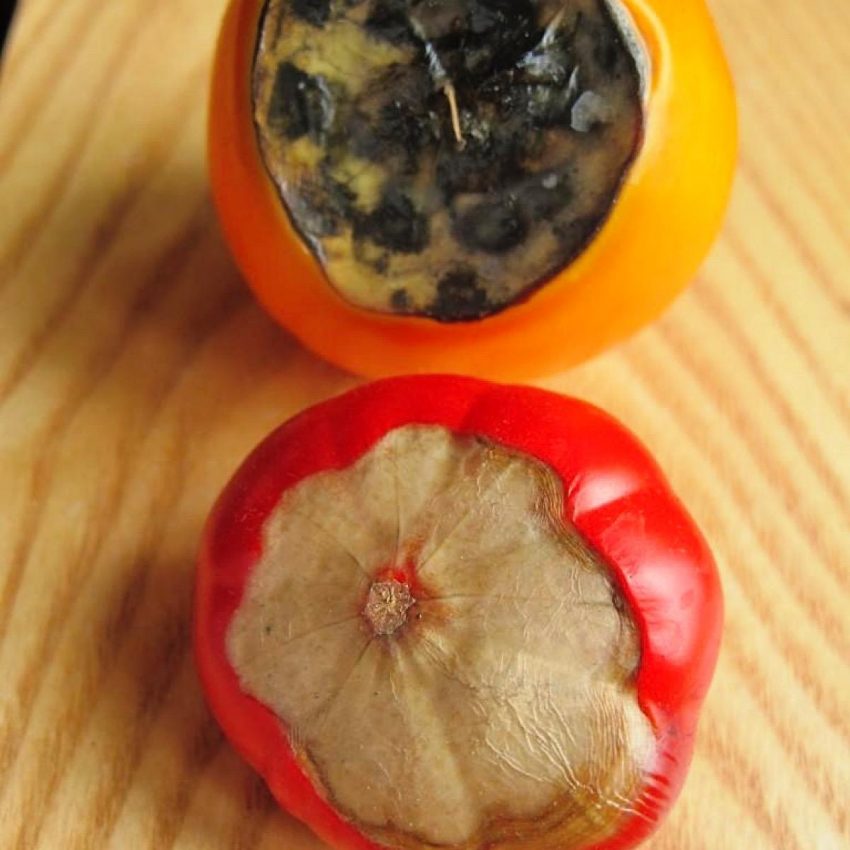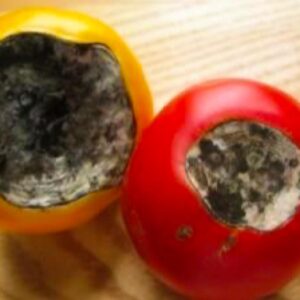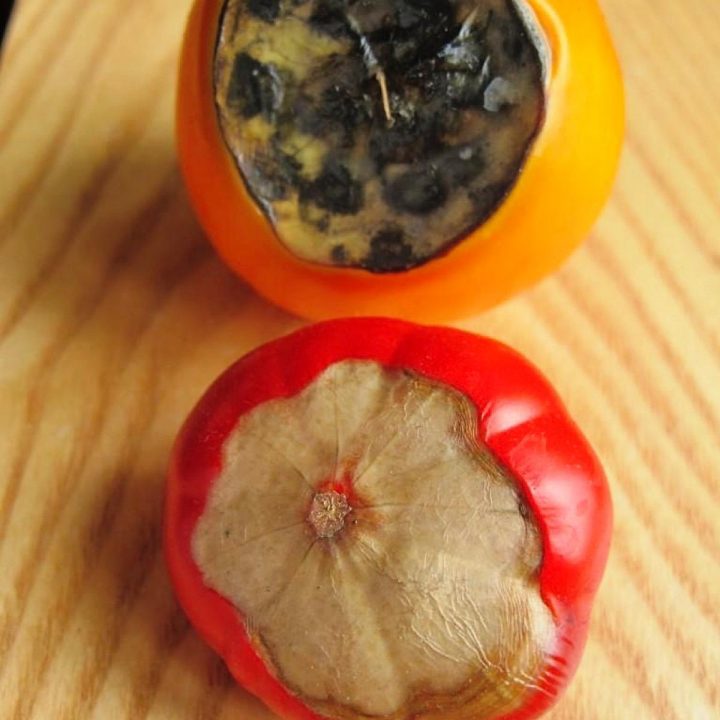Growing tomatoes in containers and pots is a great solution if you are in need of space or have limited areas with sun. Container growing does have its trials and tribulations however, and blossom end rot is a disease that is fairly common when growing tomatoes in pots.
Blossom End Rot is initially a light tan, flattened area on the blossom end of the tomato which then enlarges and turns black and leathery. It often appears on the first flush of the tomato plant, with the tomatoes coming on after that being healthy.

This post may contain affiliate links. As an Amazon Associate, I also earn from qualifying purchases. You can read our disclosure information here–
Prevention of Blossom End Rot
This disease is caused by a localized calcium and mineral deficiency in the developing fruit. This deficiency is usually caused by an inconsistent watering regime, i.e., a dry-wet-dry cycle of watering.
Tomato plants prefer about one inch of water per week, and if you allow them to get quite dry in the pots, and then deluge them with water when you notice wilting, you are setting yourself up for blossom end rot.
The following tips will help in preventing the disease:
- Mulch the soil around the plant to reduce moisture fluctuations;
- If rainfall is less than 1 inch per week, soak the soil slowly with water from a hose or set up a soaker hose (sprinklers or watering from above can splash soil onto the plant’s leaves and promote other diseases);
- If you grow in pots each year, make sure and use fresh potting soil each year;
- Select disease resistant varieties of tomatoes, and consider growing determinate tomatoes. Determinate tomatoes are shorter and bushier than indeterminate and they do not continue growing until frost, so they do not vine and outgrow the trellis or stakes you may have in your pots. With determinates you will get a lot of tomatoes over a 3 to 4 week period rather than fewer tomatoes over a longer period (all summer) as with indeterminates. Most heirloom varieties are indeterminate, but a few examples of determinate heirloom varieties that grow well in pots are: Raspberry Lyanna, Manitoba, Principe Borghese, Prescott, and Black Sea Man. You can certainly grow indeterminate tomatoes (heirloom or hybrid) in pots, they are just higher maintenance;
- Select plastic or fiberglass pots rather than clay pots. Clay pots dry out too fast and it is harder to regulate the water regime. A self-watering container, EarthBox Organic, Terracotta, or home-made wicking system is even better.
Other tips include
- Don’t plant the tomatoes when the soil is too cool (affects early fruits)
- Don’t overfertilize with nitrogen
- Be careful not to injure the roots when weeding near the plants.
Take Note: Some sources recommend calcium chloride sprays on the foliage but use caution with these. They can cause plant injury and some reliable sources say they don’t really help.
Possible Cures
All is not lost if your first flush of tomatoes has blossom end rot. It is not a disease that lives in the soil like blight so it is certainly possible to save the remaining tomatoes.
Follow these steps and you can still enjoy a large harvest for the remaining part of summer:
- Set up a soaker hose system, transplant to a self-watering container, or be very conscientious about seeing that the pot does not dry out to less than 1 inch of water a week (and water the soil, not the leaves if using a hose or watering can);
- While Calcium deficiency is one of the causes of blossom end rot, the idea of adding calcium to the soil is not necessarily the answer.
This quote from plantvillage.psu.edu summarizes the calcium issue very well:
“While blossom end rot is caused by a lack of calcium to the developing fruits, it doesn’t mean there isn’t enough calcium in the soil. It is most often related to an inconsistent amount of water in the soil or being taken up by the plant.
plantvillage.psu.edu
Calcium is brought to the fruit in the water the plant takes up from the soil so allowing the soil to dry out too much between waterings can cause blossom end rot. Pot-grown tomatoes are especially susceptible.
So, to sum up: water management is the primary factor in preventing and curing Blossom End Rot on tomatoes.

Happy Trails…….
If you like my articles about cooking and gardening, subscribe to my weekly newsletter, where I share free recipes and gardening tutorials.


thank you, i think many gardens don’t realize the importance of mulch, again i see that word over and over again. fundamentals WATER RETENTION, i do believe i have a calcium deficiency as well, thanks for the site
Certainly Pistol Pete. I hope it helped a bit. The next post will deal with late blight. Hopefully you don’t have that problem, but so many heirlooms get it that I thought I’d try to address it. Thanks for the comment!
[…] are likely to have problems with the potting mix drying out, which can lead to blossom end rot (see this post to help with blossom end rot). The larger indeterminate heirloom tomatoes will grow well in 12-18 […]
I just threw away four enormous tomato plants due to blossom end rot. I planted Russian black krim heirloom tomatoes, which I love, in plastic pots. Unfortunately, with our hot, humid Maryland summers, they dry out quickly in the pots. The plants thrived and had lots of fruit, but they were riddled with blossom end rot. I tried adding calcium (Tums, eggshells, special sprays, calcium products, etc.), to no avail. I picked off the damaged fruit early on, added mulch over the soil, and so on. Nothing helped. The fruit continued rotting on the vine, so I finally gave up last night and chopped them down. This has happened for several years now. I’m wondering if I would have better luck using wooden containers instead of plastic. Ideas?
I’ve just noticed what appears to be Blossom End Rot on some of my Marmande and Roma tomatoes which I am growing in an Autopot system, This appears to be functioning correctly with a consistent flow so I therefore suspect calcium deficiency to be causing the problem. I see that you suggest the use of Epsom Salts to overcome this, but surely this is a magnesium rather a calcium salt or have I got it wrong! P’d like your comments, Tom
You’re right it is a magnesium salt Tom. The best thing you can do for blossom end rot is consistent watering, not letting it get too dry and then watering too much is usually the culprit. Remove the ones with blossom end rot. It is likely that the next flush of tomatoes on that plant will not have it.
Please… from a Chemical Engineer: Epsom Salts contain Magnesium which is beneficial to plants.. but it does not provide Calcium.
Thank you DDD for clarifying that. I trust your knowledge over mine on this. I can’t remember the sources where I got this information, but I know it was more than one source. Now I’ll have to research to see if it is the magnesium which helps prevent blossom end rot, or if Epsom salts as a preventive cure is just folklore.
Blossom end rot is more commom on high yielding varieties like ASRA FI grown in dry period, The disease is rarely noticed in tomatoes grown in the rainy period.
I haven’t found this to be true with heirlooms. Some are more susceptibe rainy period or dry, depending on how “consistent” the watering regime is. They are also more susceptible when grown in pots and the potassium and magnesium are leached out without replacement.
Just picked first fruit….end rot, as described. I have hundreds to follow and pray/hope it won’t affect them all. I am very strict with watering regime so am uncertain where I have gone wrong. Hopefully all the rest will be fine…….
Will add some compost around bases…fingers crossed.
Pots in a tray 1 inch of water in tray will it stop blossom end rott
It’s not a matter of how much water it’s all about a “consistent” amount of water and not letting the plants dry out and then get drowned with water.
I have found success in eliminating blossom end rot by placing crushed egg shells in the holes where I plant my tomatoes. I believe the extra calcium supply to the roots is very helpful !!!!!
I think I’ll need to water 2 times a day, otherwise the leaves being to wilt/droop by the evening, on a few of my potted plants. The Blossom End Rot is very disappointing. Already pulled tomatoes off 3 plants and tossed in the compost. When I planted them into the pots, I put some Bone Meal on the bottom, just to give them some extra calcium, but that doesn’t seem to help, and I’m not sure I’ll be able to water twice a day.
I’ll try adding epsom salts and mulch, and see if that helps…I’ll try anything at this point….
[…] are likely to have problems with the potting mix drying out, which can lead to blossom end rot (see this post to help with blossom end rot). The larger indeterminate heirloom tomatoes will grow well in 12-18 […]
I think some varieties are more susceptible to BER than others. I grow in self watering containers so the right amount of water is always available. Last year I planted 6 varieties and 4 became infected with BER and 2 (Stupice, Early Girl) did not. I plan to treat all plants with 4Tbs/gal water of calcium nitrate this year prior to blossoming.
Yes, I definitely agree that some varieties are more susceptible than others. Some of the smaller varieties and some of the roma types seem to be more susceptible than the large beefsteak varieties. The descriptions in the seed catalogs will often note which ones are most disease resistant, and although that usually refers to vertimicillan wilt, sometimes it will note BER. The calcium nitrate prevention should help.
Certainly Carol! It gives me a lot of satisfaction to know I may have helped someone out, no matter how small. Thanks for commenting